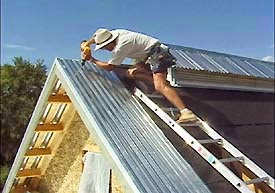If you are considering hiring a Chicago roofing and siding contractor, or doing the work yourself, you must account for the entire job – not just the installation. The final finish for roofing and siding is what will largely determine the lifespan of the material. You need to know a few ins and outs of the materials and types of finish before starting to ensure a good job.
What does the final finish look like?
The final finish on a roofing or siding project can vary greatly. For some types of siding, the final finish is trim and paint. For many types of roofs, it is just the cleanup and flashing. If you are installing a slate or terracotta roof, it may need to be sealed as well. The same may hold true for wood siding or shingles. If sealing and painting are in order, this can be a multi-day project that is dependent on the weather - temperature, humidity and sun exposure.
For some materials, the finish is the clean-up
Some of the nylon siding and many of the asphalt roofing types require only a cleanup for finishing. This doesn't simply mean a nail sweep, but can also include the final trim work and back filling. Many Chicago roofing company contractors will not do the final fill on the siding job; that is generally left to the landscaper or general contractor. If you reside in a home, they may even work around having to actually excavate. Make sure you know what the contractor's plans are first so you don't get left with a surprise trench to fill in later.
Making sure that painting and sealing is scheduled right
No matter what type of material you have selected to have your Chicago roofing and siding contractor install, it has to be painted or sealed. This is where a lot of jobs can go wrong. If you push a contractor to “wrap it up” you may wind up with material that will fail. If you are doing the work yourself, for successful application, you need to follow the directions closely and find out the climate adaptations to humidity and altitude unique to Chicago.
How much of the work should you do?
This is the real question for those who are on a tight budget. Many times, you can ask a Chicago roofing and siding contractor what work you can assume to lower your cost. They will most likely suggest the cleanup and staging - as the other aspects of the job are time consuming and technically demanding. For many types of siding, like fiber cement, you can do some of it yourself. Bear in mind what your insurance will cover before you start doing anything.
Source: Click Here
What does the final finish look like?
The final finish on a roofing or siding project can vary greatly. For some types of siding, the final finish is trim and paint. For many types of roofs, it is just the cleanup and flashing. If you are installing a slate or terracotta roof, it may need to be sealed as well. The same may hold true for wood siding or shingles. If sealing and painting are in order, this can be a multi-day project that is dependent on the weather - temperature, humidity and sun exposure.
For some materials, the finish is the clean-up
Some of the nylon siding and many of the asphalt roofing types require only a cleanup for finishing. This doesn't simply mean a nail sweep, but can also include the final trim work and back filling. Many Chicago roofing company contractors will not do the final fill on the siding job; that is generally left to the landscaper or general contractor. If you reside in a home, they may even work around having to actually excavate. Make sure you know what the contractor's plans are first so you don't get left with a surprise trench to fill in later.
Making sure that painting and sealing is scheduled right
No matter what type of material you have selected to have your Chicago roofing and siding contractor install, it has to be painted or sealed. This is where a lot of jobs can go wrong. If you push a contractor to “wrap it up” you may wind up with material that will fail. If you are doing the work yourself, for successful application, you need to follow the directions closely and find out the climate adaptations to humidity and altitude unique to Chicago.
How much of the work should you do?
This is the real question for those who are on a tight budget. Many times, you can ask a Chicago roofing and siding contractor what work you can assume to lower your cost. They will most likely suggest the cleanup and staging - as the other aspects of the job are time consuming and technically demanding. For many types of siding, like fiber cement, you can do some of it yourself. Bear in mind what your insurance will cover before you start doing anything.
Source: Click Here










